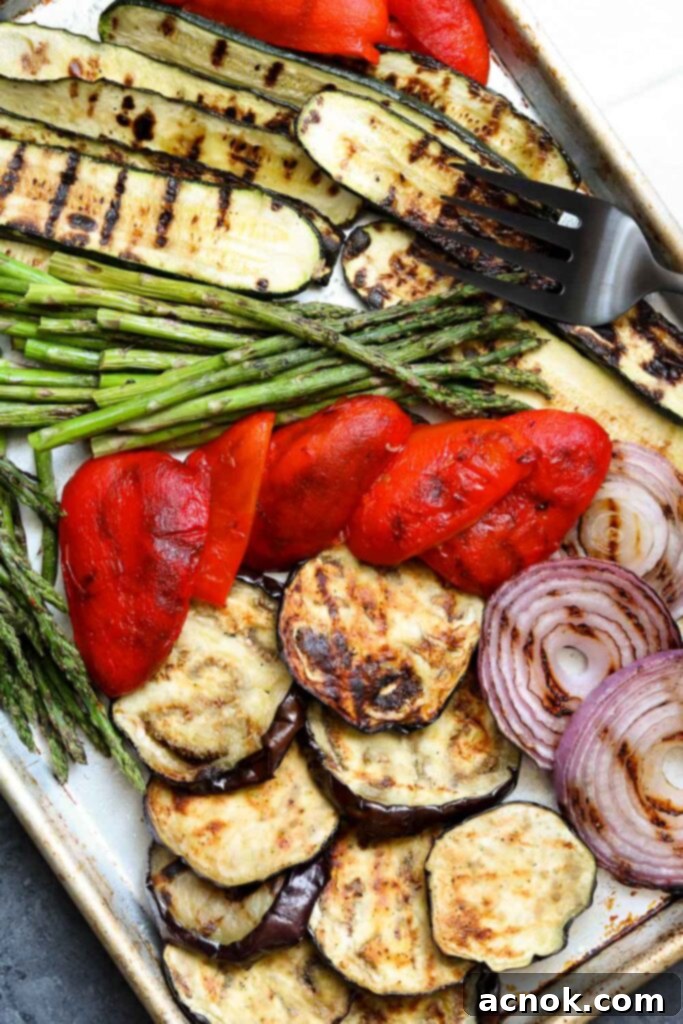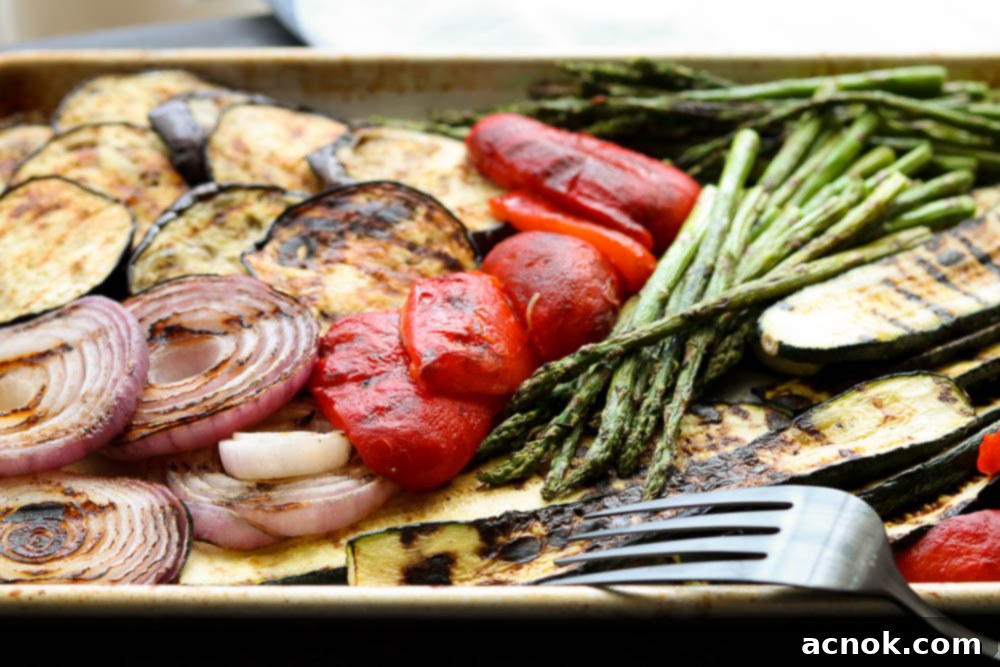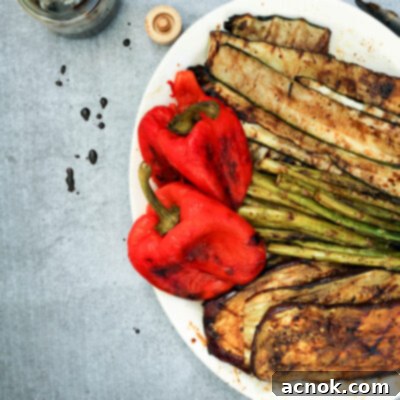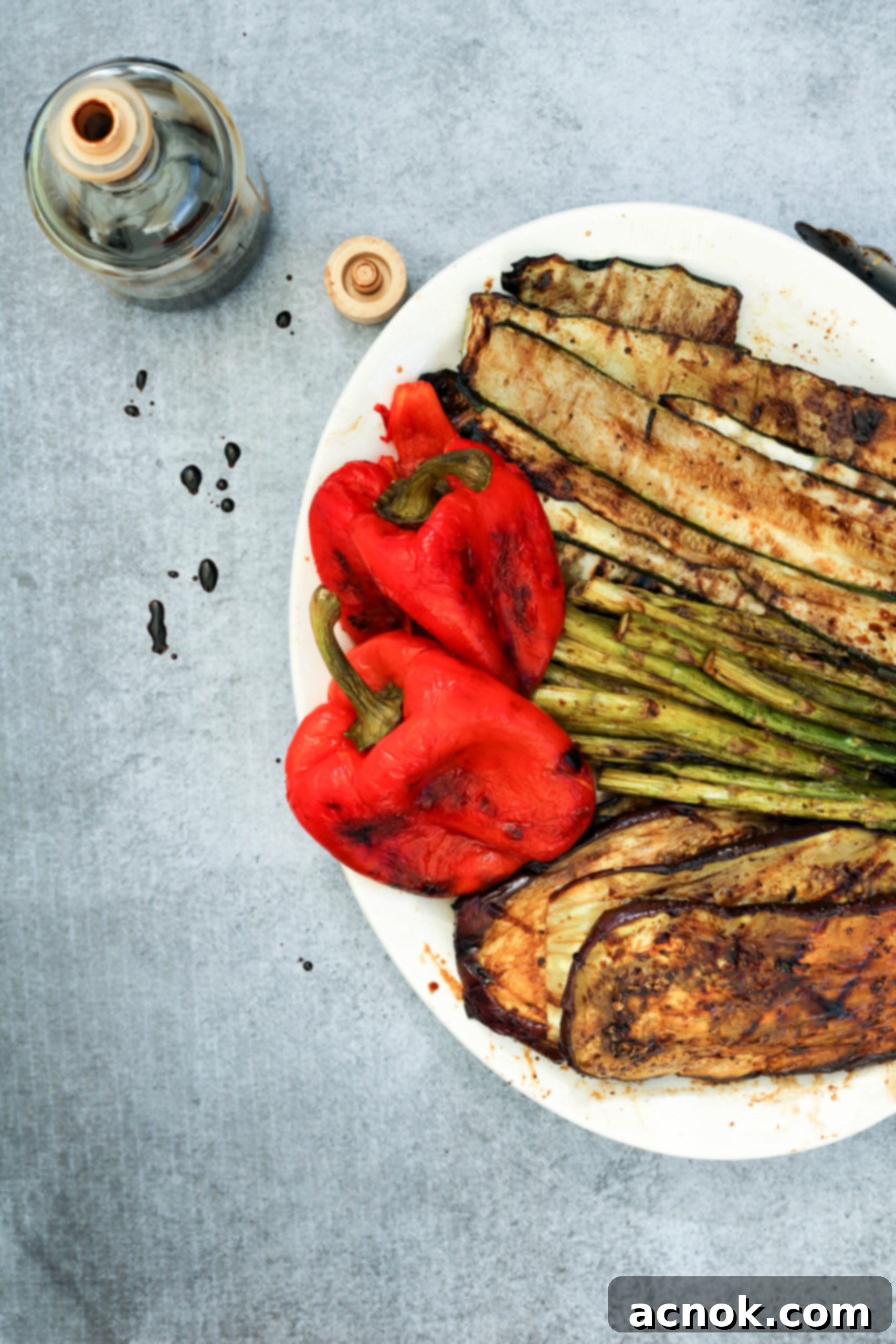Mastering Balsamic Grilled Vegetables: Your Ultimate Guide to Flavorful & Versatile Meals
Balsamic Grilled Vegetables are more than just a side dish; they’re a culinary cornerstone in our home, offering endless possibilities for quick, healthy, and incredibly flavorful weeknight meals. This versatile recipe, showcasing the vibrant flavors of eggplant, zucchini, asparagus, and bell peppers, is a testament to how simple ingredients can transform into something truly extraordinary on the grill. While today’s focus includes asparagus (perfect for an Open-Face Asparagus and Tomato Sandwich!), don’t hesitate to experiment with your favorites – portobello mushrooms, yellow squash, or even thinly sliced potatoes. The beauty of balsamic grilled vegetables lies in their adaptability, allowing you to create a variety of delicious dishes from a single batch. And for those without a grill, fear not! We’ll also touch upon an easy Balsamic Roasted Vegetables method, perfect for your oven.
This comprehensive guide will walk you through everything you need to know, from selecting the freshest produce and mastering the grilling technique to exploring creative ways to incorporate these delectable veggies into your daily meals. Get ready to elevate your cooking with this simple yet sophisticated staple that promises both taste and convenience.
Why Balsamic Grilled Vegetables Are a Kitchen Essential
The appeal of balsamic grilled vegetables goes far beyond their delicious taste. They represent a harmonious blend of health, convenience, and versatility, making them an indispensable part of a balanced diet. Grilling brings out the natural sweetness of vegetables, while a tangy balsamic marinade adds a layer of rich, savory flavor without overwhelming the inherent freshness of the produce. This cooking method is inherently healthy, requiring minimal oil compared to other preparations, and it locks in essential nutrients. Furthermore, a batch of grilled vegetables can serve as a versatile foundation for multiple meals throughout the week, significantly reducing cooking time and effort during busy evenings.
Whether you’re planning a backyard barbecue, a simple family dinner, or actively meal prepping for a healthier week, these vegetables fit perfectly into any culinary agenda. They are naturally vegan, vegetarian, gluten-free, and can be easily adapted to various dietary preferences, ensuring they are a crowd-pleaser for everyone at your table. Their delightful char and robust flavor make them a standout addition to any dish, proving that healthy eating can also be incredibly delicious and exciting.
Selecting and Preparing Your Vegetables for Grilling
The success of your grilled vegetables begins with choosing the right produce and preparing it properly. For this recipe, we’ll focus on eggplant, zucchini, and bell peppers, but feel free to add other grill-friendly options based on your preference and seasonal availability.
Eggplant: The Creamy Canvas
When selecting eggplant, aim for a firm, medium-sized vegetable. Look for ones with smooth, taut, and glossy skin, entirely free from bruises, soft spots, or significant markings. Bruised eggplants, when cut open, can often reveal brown spots and a mealy texture, which is less appealing for grilling. To prepare, simply trim the stem and slice the eggplant lengthwise into uniform planks, approximately 1/4 inch thick. This precise thickness is crucial as it ensures they cook evenly on the grill, achieving a delightful tenderness while still retaining a satisfying structural integrity without becoming overly mushy.
Zucchini & Yellow Squash: The Tender Touch
For zucchini (or its equally delicious counterpart, yellow squash), select medium to large-sized varieties that are firm to the touch. It’s generally best to avoid overly large squash, as they can sometimes be watery, have larger seeds, and possess a less concentrated flavor. Like the eggplant, trim both ends of the squash and slice them lengthwise into 1/4-inch thick pieces. Their relatively quick cooking time makes them an excellent and reliable grilling companion, offering a pleasant, tender texture and mild flavor that perfectly complements the balsamic marinade.
Bell Peppers: Burst of Color and Sweetness
Red bell peppers are often preferred for their striking vibrant color and naturally sweet flavor that intensifies beautifully when grilled. However, do not hesitate to use orange, yellow, or even a mix of colors to create a more visually appealing and diverse platter. For grilling, you’ll generally use these peppers whole. The charring process on the grill dramatically transforms their texture and flavor profile, yielding a wonderfully tender interior with a smoky, sweet essence that is truly irresistible. Ensure your chosen peppers are firm, bright, and free from any blemishes or soft spots to guarantee the best results.
Other Great Grilling Options
The world of grilled vegetables is vast and exciting! Don’t limit yourself to just these three. Consider adding large portobello mushroom caps, thick slices of sweet onion, cherry tomatoes threaded onto skewers, or even sturdy leafy greens like romaine lettuce halves for a unique charred flavor. Remember that different vegetables have varying densities and water content, so you’ll need to adjust slicing thickness and grilling times accordingly to ensure each one reaches its perfect doneness. Experimentation is highly encouraged to discover your personal favorite combinations!

The Art of Grilling Balsamic Vegetables
Achieving perfectly grilled vegetables requires a few simple yet crucial steps and a watchful eye. Here’s how to master the technique and bring out their best, most succulent flavors:
Preparing the Balsamic Olive Oil Mixture
The heart of this recipe lies in its flavorful marinade. Before you even think about firing up the grill, ensure your balsamic olive oil mixture is ready. In a small bowl, meticulously whisk together 4 tablespoons of high-quality extra virgin olive oil, 3 tablespoons of rich balsamic vinegar, 1 teaspoon of kosher salt (which enhances flavor more effectively than regular table salt), 0.5 teaspoon of freshly ground black pepper, 1 minced clove of garlic (for an aromatic kick), and 1 teaspoon of dried Italian seasoning until all ingredients are thoroughly combined and emulsified. This potent blend will deeply infuse your vegetables with incredible flavor and aid in their beautiful caramelization on the hot grates.
Pre-Grill Preparation: Optimal Oil and Initial Seasoning
Once your vegetables are uniformly sliced as described above, lightly spray or brush them with a thin, even coat of olive oil. This crucial step serves a dual purpose: it prevents the vegetables from sticking to the grill grates, ensuring easy flipping and pristine grill marks, and it contributes to a lovely exterior char. The whole bell peppers, which require a different cooking approach, only need a light coat of oil along with a modest sprinkle of salt and pepper to season their skin. For better organization and efficient grilling, it’s advisable to keep all prepared vegetables separated on trays or plates before they hit the grill.

Grill Temperature and Strategic Placement
Preheat your grill to a consistent medium heat, aiming for an approximate temperature of 400 degrees Fahrenheit (200 degrees Celsius). Once the grill is thoroughly hot, it’s time to strategically arrange your vegetable slices. Place the eggplant and zucchini directly on the main grilling grates. If you happen to have some thicker slices, intelligently position them over the hottest areas of the grill to ensure they cook through evenly and develop a deep char. The whole bell peppers, which require a slower, more gentle roast to fully soften and sweeten, should be placed on the top rack of your grill or in a cooler, indirect heat zone at the back. This separation ensures optimal cooking for each type of vegetable.
The Grilling Process: Patience and Flavor Brushing
For the delicate eggplant and squash, constant attention and frequent turning are paramount to prevent them from burning. Turn them diligently every 2-3 minutes, observing closely until they begin to tenderize and develop those characteristic, appealing grill marks. Once they reach this crucial stage, begin brushing them generously with your expertly prepared balsamic olive oil mixture. Continue to turn and brush a few more times, allowing the rich flavors to deeply meld and the vegetables to achieve a beautiful, subtle caramelization. The ultimate goal is a tender, yet not overly mushy texture, maintaining a slight firmness that ensures they hold their shape perfectly.
Meanwhile, the bell peppers on the top rack are steadily on their slow roasting journey. Turn them occasionally, allowing their skins to evenly char and blister. This charring is not merely aesthetic; it is an essential step that contributes significantly to their smoky flavor and makes the subsequent peeling process considerably easier and more efficient.
Achieving Perfect Doneness and Expert Pepper Handling
It is crucial to exercise caution and avoid overcooking any of your vegetables. The ideal consistency is tender enough to eat comfortably, yet still firm enough to handle without disintegrating. Overcooked vegetables tend to become watery, lose their vibrant color, and can develop an undesirable mushy texture. Precision in timing is key to maintaining their delightful bite and nutritional integrity.
Once the bell peppers are thoroughly charred and beautifully blistered on all sides, promptly remove them from the grill. Immediately transfer them to a resealable plastic bag or place them in a bowl covered tightly with plastic wrap. Seal the bag or cover the bowl securely and allow the peppers to steam for approximately 10-15 minutes. This steaming process creates a humid environment that effectively loosens the charred outer skin, making it incredibly easy to peel away. Once cooled enough to safely handle, remove the peppers from the bag, carefully peel off the charred skin, discard the stem and seeds, and then slice them into strips or dice them as desired for your upcoming recipes. What you’ll be left with are exquisitely tender, intensely sweet, and beautifully smoky roasted peppers – a true testament to the “pepper love” you put into them!
No Grill? No Problem! Try Balsamic Roasted Vegetables in the Oven!
If you don’t have access to a grill or simply prefer an indoor cooking method, you can achieve similarly delicious results by roasting your balsamic vegetables in the oven. The process is straightforward and yields tender, flavorful veggies every time. Simply preheat your oven to a robust 400°F (200°C). Take your prepared, sliced vegetables (eggplant, zucchini, bell peppers, and any other favorites) and toss them thoroughly with the balsamic olive oil mixture on a large baking sheet. Ensure the vegetables are spread out in a single layer to promote even roasting and browning – overcrowding can lead to steaming instead of roasting. Roast for approximately 20-30 minutes, remembering to flip them halfway through the cooking time, until they are tender and exhibit a lovely, slightly caramelized edge. The whole bell peppers can be roasted alongside the other vegetables and then treated in the exact same way as grilled peppers for steaming and peeling, guaranteeing that same smoky-sweet tender interior.
Elevate Your Meals: Creative Ways to Use Balsamic Grilled Vegetables
Once you have a batch of these glorious balsamic grilled vegetables on hand, the culinary possibilities truly become endless. Their rich flavor and tender texture make them an incredibly versatile ingredient, capable of transforming simple dishes into spectacular meals. Here are some of our absolute favorite ways to incorporate them:
- Gourmet Grilled Vegetable Sandwiches with Asiago and Pesto: Elevate your sandwich game by layering your perfectly grilled eggplant, zucchini, and peppers on artisanal, crusty bread. Add generous smears of vibrant basil pesto and a few slices of sharp Asiago cheese. A quick press in a panini maker or a few minutes under the broiler will melt the cheese beautifully and create an irresistible, hearty lunch or a satisfying light dinner that bursts with Mediterranean flavors.
- Hearty Grilled Vegetable Rigatoni with Feta and Kalamata Olives: This Mediterranean-inspired pasta dish is both simple and deeply flavorful. Toss warm, al dente rigatoni pasta with your coarsely chopped grilled vegetables, generous crumbles of tangy feta cheese, and briny Kalamata olives. A final drizzle of high-quality extra virgin olive oil and a sprinkle of fresh parsley or oregano completes this delightful and wholesome meal.
- Elegant Grilled Vegetable Appetizer with Whipped Za’atar Feta and Crusty Bread: For an impressive yet effortless appetizer, artfully arrange your grilled vegetables on a beautiful platter. Serve them alongside a creamy, luscious whipped feta (prepared by blending feta cheese with a touch of olive oil and aromatic Za’atar spice) and plenty of thinly sliced, crusty baguette. This combination offers a delightful interplay of textures and flavors.
- Nutrient-Rich Grain Bowls & Salads: Instantly add a colorful, flavorful, and nutrient-packed boost to any grain bowl (featuring quinoa, farro, couscous, or brown rice) or a simple green salad. These grilled vegetables pair wonderfully with a zesty lemon-tahini dressing, a classic balsamic vinaigrette, or even a creamy avocado dressing.
- Healthy Wraps & Tacos: For a quick and satisfying meal, roll them up in a whole wheat tortilla with a spread of hummus, a creamy aioli, or a spicy chipotle sauce. Alternatively, chop them finely and use them as a vibrant, flavorful filling for vegetarian tacos, topped with fresh salsa and a squeeze of lime.
- Flavorful Frittatas & Omelets: Incorporate finely diced grilled vegetables into your morning frittata or omelet for a healthy, robustly flavored start to your day. Their pre-cooked nature saves time and adds depth to your egg dishes.
- Gourmet Pizza Topping: Transform an ordinary pizza into a gourmet creation. Spread a thin layer of your favorite tomato sauce on pizza dough, top with shredded mozzarella, and scatter generously with chopped grilled vegetables before baking until bubbly and golden. This adds a sophisticated and healthy twist to classic pizza.
Tips for Grilling Success
To ensure your balsamic grilled vegetables turn out perfectly every time, keep these essential tips in mind:
- Ensure Even Slicing: Uniform slices are paramount for achieving consistent cooking. Irregularly cut vegetables will cook at different rates, leading to some pieces being undercooked or overdone.
- Do Not Overcrowd the Grill: Resist the temptation to load too many vegetables onto the grates at once. Give your vegetables ample space to breathe and allow for proper charring. Overcrowding will lower the grill temperature and cause the vegetables to steam rather than grill, preventing that desirable smoky flavor and caramelization.
- Watch the Heat Closely: Always keep a vigilant eye on your grill temperature and be prepared to adjust it as needed. Thinner slices, in particular, can burn quickly if the heat is too high. Maintain a steady medium heat for best results.
- Prioritize Quality Ingredients: The foundation of any delicious dish lies in its ingredients. Starting with fresh, high-quality vegetables and a good balsamic vinegar makes an immense difference in the final flavor profile and overall enjoyment of your grilled creations.
- Don’t Be Afraid to Experiment: Culinary exploration is half the fun! Don’t hesitate to try grilling different vegetables that you enjoy or adding a touch of fresh herbs like fragrant rosemary or earthy thyme directly to your balsamic mixture for an added layer of flavor complexity.
Storage and Reheating
Balsamic grilled vegetables are exceptionally well-suited for meal prepping, allowing you to enjoy their deliciousness throughout the week. Once they have thoroughly cooled to room temperature, store them in an airtight container in the refrigerator. They will maintain their quality and flavor for up to 3-4 days. These versatile vegetables are just as delicious served cold in salads, as part of an antipasto platter, or at room temperature. To reheat, you have several options: gently warm them in a pan on the stovetop over medium-low heat until just heated through, briefly place them in the oven at a low temperature (around 300°F or 150°C), or quickly microwave them. Be cautious not to overheat, as excessive reheating can diminish their texture and make them mushy.
And there you have it! A simple yet profoundly satisfying way to enjoy vegetables that will quickly become a cherished favorite in your culinary repertoire. Whether prepared for a quick, healthy meal or presented as an elegant, flavor-packed appetizer, these balsamic grilled vegetables consistently deliver on taste, nutritional value, and remarkable versatility. Enjoy the delightful flavors of the grill!
If you tried this recipe, please help other readers by commenting below and sharing some stars! We 🫶🏼 appreciate you!
All content and photographs ©Claudia’s Table and claudiastable.com

Balsamic Grilled Vegetables
Ana | Claudia’s Table
May 27, 2019
Pin Recipe
Ingredients
- 1 Eggplant medium
- 2 Zucchini medium to large
- 2 Red Peppers Whole
For Balsamic olive oil mixture
- 4 tbsp olive oil extra virgin
- 3 tbsp balsamic vinegar
- 1 tsp salt kosher
- .5 tsp pepper
- 1 clove garlic minced
- 1 tsp italian seasoning dry
Instructions
-
I start with a firm, medium sized eggplant. I tried to avoid buying an eggplant with bruising or markings as these seem to bruise easily and when you cut it open it will be brown. To be honest, I don’t know if it’s critical, I just don’t prefer it. Then I move on to some zucchini squash. You can use yellow squash as well. They work the same. Then I add peppers…I prefer red. You can use any other color…orange, yellow or green or a combo. Whatever makes your heart aflutter.
So I trim the eggplants stem, cut into lengthwise slices about 1/4 inch thick. Zucchini ? Same. I spray the vegetables with olive oil so they don’t stick to the grill and I leave the peppers as they are…I grill all of them together in one batch.
Before you start grilling, make sure you have the Balsamic olive oil mixture ready to go. The vegetables will start cooking quickly. Mix Olive oil, Vinegar, salt, pepper, garlic and seasoning in small bowl. Whisk until mixed.
Heat your grill to medium heat..somewhere around 400 degrees. Once hot, arrange your vegetable slices on the grill. If you happen to cut some thicker slices, place those on the hottest area of your grill. The peppers? I place those on the top rack in the back of the grill. For the eggplant and squash, I keep an eye that I don’t burn them. I keep turning and turning until they are starting to get tender. From there, I brush on the Balsamic vinegar olive oil mixture. I turn a few more times doing the same. The peppers? They are the on the sidelines, roasting away. I also turn them, but not as frequently. I turn them as they char on their sides.
Be careful not to overcook the veggies. You want them to be tender to eat but have some firmness. Firm enough to handle and it doesn’t fall apart in your hands. Also, once the peppers are charred on all sides, remove from grill and place in a ziplock back. Zip it up and let the steam work its magic. I let the peppers cool enough to handle. Once they are cooled off, take them out of the bag and peel the charred skin. What you will be left with is just Pepper love …tender roasted peppers. I typically, remove the stem, charred skin and seeds. I cut them into strips that are good for me and whatever I’m planning. You can cut them up in any way that you would like for whatever purpose you desire.
Notes
Nutrition
Nutritional information is calculated online and should be used as a guide.
All content and photographs ©Claudia’s Table and claudiastable.com
